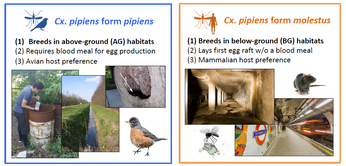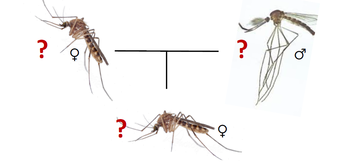 Figure 1: Cx. pipiens – one species with two bioforms: form pipiens and form molestus (image credit: Anna Noreuil). Figure 1: Cx. pipiens – one species with two bioforms: form pipiens and form molestus (image credit: Anna Noreuil). written by: Mike Nan, PhD student, St. Leger lab and Dylan Kutz, MS student, Lamp lab Anna Noreuil, an M.S. student in the Fritz Lab in the Department of Entomology at the University of Maryland, has been studying host-seeking behavior and differential chemosensory gene expression in above- and below-ground Culex pipiens for her master’s research. Cx. pipiens (Diptera: Culicidae) is a mosquito found in the northern regions of the U.S. and is also found in urban and suburban temperate areas around the world. Cx. pipiens is the primary vector of West Nile virus (WNV), a mosquito-borne disease that affects the nervous system, in the Northeastern US. Oddly, although there is only one species known as Cx. pipiens, two “bioforms” of the species exist which are morphologically indistinguishable but genetically, physiologically, and behaviorally different: “Cx. pipiens form pipiens” and “Cx. pipiens form molestus.” Cx. pipiens form pipiens differs from Cx. pipiens form molestus in three distinct ways: (1) it breeds in above-ground habitats, (2) it requires blood meals for egg production, and (3) it prefers avian hosts over humans (Figure 1). However, these two “bioforms” readily hybridize or crossbreed and as such they are both classified as the same species (Figure 2).  Figure 2: The differences between Cx. pipiens bioforms and hybrids are not obvious by sight alone. Question marks illustrate the difficulty in telling apart the two forms pipiens and molestus and hybrids without employing DNA-focused molecular approaches (image credit: Anna Noreuil). Figure 2: The differences between Cx. pipiens bioforms and hybrids are not obvious by sight alone. Question marks illustrate the difficulty in telling apart the two forms pipiens and molestus and hybrids without employing DNA-focused molecular approaches (image credit: Anna Noreuil). The most remarkable difference in the peculiar biology of Cx. pipiens is the disparity between the two forms in their reproductive requirements. As is typical for female mosquitoes, the pipiens bio-form requires a blood meal to produce eggs. Without the necessary proteins and amino acids contained in a blood meal, the female mosquitoes are unable to lay as many viable eggs. The molestus bio-form, however, does not require a blood meal to produce its first egg raft. How Cx. pipiens detect and select hosts is also a point of interest for the species. Cx. pipiens uses a wide array of internal cues such as age, life stage, circadian clock, blood-feeding rhythms, and experience to guide its host detection and selection. External cues, such as carbon dioxide expelled during respiration, local increases in temperature and humidity, and odorants emitted from skin and breath also help mosquitoes find their host of choice. With this background information about Cx. pipiens in mind, Noreuil set out to characterize the genetic ancestry of Cx. pipiens bioforms and quantify their host preferences. Ultimately, her goal was to figure out if their genetic ancestry dictates the differences in the mosquitoes’ host selection. Noreuil characterized the genetic ancestry of above- and below-ground populations of both Cx. pipiens bioforms using various DNA-focused molecular techniques and found that genetic ancestry varied significantly across above- and below-ground mosquito populations. Furthermore, Noreuil performed host-choice experiments – i.e. female mosquitoes were scored based on whether they chose the human or chicken host for a blood meal – to determine the host preference of each population. Noreuil’s results indicated that the genetic ancestry of the mosquito populations may not indicate the host preference of the mosquitoes, at least in the case of this assay.  Figure 3: OBPs contribute to host specialization behaviors in other Dipterans (image credit: Anna Noreuil). Figure 3: OBPs contribute to host specialization behaviors in other Dipterans (image credit: Anna Noreuil). Next, Noreuil shifted her focus to the expression patterns of odorant-binding proteins (OBPs) in Cx. pipiens to determine if they are responsible for the observed differences in host preference between above- and below-ground populations. OBPs are small chemoreception proteins in insects that essentially let insects “smell” chemical odors in their environment by transporting environmental odorants to antennal receptors. Noreuil was inspired to investigate OBPs due to similar host specialization behaviors in Drosophila sechellia, which uses the odor of the ripe fruit of its host plant, Morinda citrifolia, to locate the fruit, while close relative Drosophila melanogaster does not (Figure 3). OBPs are already known to be vital in mosquitoes for the reception of certain odorants and many chemosensory genes appear to be regulated by their circadian clock. Noreuil’s research revealed that OBPs are vital for selectivity and sensitivity of the mosquito olfactory system and may be instrumental in detecting host-specific volatiles to influence host-seeking behavior. Based on her preliminary RNA-sequencing results, she compared the expression of OBP2 and OBP12 between one below-ground human-seeking population and one above-ground bird-seeking population. After characterizing expression of these two OBPs, Noreuil discovered that both OBPs were more highly expressed in the heads of the form molestus below-ground human-seeking population during the life stage the mosquitoes would be engaging in host-seeking behavior. This finding indicates that the two OBPs may play a role in human host detection. Overall, Noreuil’s master’s research provides new insight into the differences between mosquito populations and their ability to find their host of choice. Her research also opens opportunities for the development of anti-mosquito technologies such as mosquito baits and repellents leveraging newly gained knowledge of mosquito OBPs. Noreuil hopes to utilize her knowledge of mosquitoes in the future as she plans to pursue a medical doctorate after her master’s degree.
Further Readings:
About the Authors: Mike Nan is a PhD student in the St. Leger lab studying how circadian rhythms affect Metarhizium infection of Drosophila. Dylan Kutz is a MS student in the Lamp lab studying agricultural drainage ditches as sources of spider diversity for neighboring croplands. Comments are closed.
|
Categories
All
Archives
June 2024
|
Department of Entomology
University of Maryland
4112 Plant Sciences Building
College Park, MD 20742-4454
USA
Telephone: 301.405.3911
Fax: 301.314.9290
University of Maryland
4112 Plant Sciences Building
College Park, MD 20742-4454
USA
Telephone: 301.405.3911
Fax: 301.314.9290

 RSS Feed
RSS Feed




